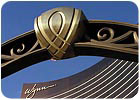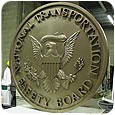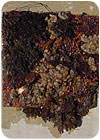
Kung Fu Fats Restaurant of Cache Creek Casino Resort in Brooks, CA, offers a lush, whimsical environment that features six large Buddha head fountains, engineered by Fabrication Arts. The fountains were hand-sculpted of high-density urethane and coated with a composite bronze metal.
Since the Stone Age drew to a close around 3500 B.C., mankind has been fascinated with metal. We picked up the occasional gold nugget and the errant lump of meteoric iron, and we coveted glittering pieces of alluvial silver. In the more than 5,000 years that followed, craftsmen and engineers have smelted, forged and hammered metals to create fantastic works of art, as well as structures that seemingly stand the test of time. Unfortunately, the material weight, expense, and heat required to work with metal have always limited its use and applications.
A new metallizing system is overcoming those limitations. From the gleaming dome high atop The Bellagio Hotel & Casino in Las Vegas to the stylized surfaces seen in films such as Batman Begins and Cat in the Hat, new composite metals are providing almost every industry with stunning, cost-effective metal surfaces.
A Cold-Sprayable Solution
The new system is composed of up to 75% metal and is cold-sprayable. The process seamlessly applies a layer of metal to almost any substrate, in virtually any configuration or design, giving the surface the appearance of a solid- cast metal object without the weight and, most importantly, without the expense. The spray-on metal looks, feels and acts like hot-cast metal, yet no heat is needed during its application. The composite metals adhere to most any surface, including foam, fiberglass, plaster and paper. Once cured, the product possesses many of the same characteristics of a cast metal, including texture, luster and heat conductivity.The system is more cost-effective than chrome plating, foundry metal, plating, vacuum metallizing and other metallizing processes, and it can be obtained in aluminum, brass, bronze, copper, iron, nickel-silver, stainless steel or other metals.
“The VIP bronze entryway at the Wynn Las Vegas is a great example of the [system’s] versatility,” says Darryl Irvine, owner of Las Vegas Awnings. “If made of solid bronze, there would have been no feasible way to structurally support the awning without massive architectural changes. But the new composite metal system provided a real bronze look and a lightweight solution with a substrate provided by Storyland Studios. The results look fantastic.”
The cost-effective properties of the new metals have also inspired a range of industrial and marine applications. For example, as water quality authorities attempt to curb cuprous oxide from leaching into marine waters from paints used on boat hulls, the marine industry quickly scrambled for new solutions to the age-old mariner’s dilemma of marine fouling.
Applied to boats and marine structures, the new metal coatings offer low toxicity to the environment and are low maintenance. In fact, metal test plates coated with the new system were placed underwater in the Great Lakes on an offshore structure, heavily-encrusted with zebra mussels. After five years, the test plates remained completely clean and free from any zebra mussel infestation and corrosion.
New Opportunities for Metal
The new coatings are cost-effective and environmentally friendly. From creating stunning decorative surfaces and unique architectural design to providing long-term protection in harsh industrial and marine environments, the composite metal coatings are expanding metallic surfaces into a range of applications.
Wynn Las Vegas
SIDEBAR:
A Safe Bet in Vegas
Creating an environment that Vegas insiders say “must be experienced to be understood,” the Wynn Las Vegas has incorporated some spectacular effects with the new composite metal system. The resort installed two 30-foot-long elaborately scrolled archways that are much lighter than they appear. Made of foam and fiberglass, the arches are finished with a composite bronze coating and provide an elegant panache at a fraction of the manufacturing costs.
The Bellagio

Seal of Approval
If made of solid bronze, the new 5-ft-diameter seal for the National Transportation & Safety Board would have weighed more than 1,000 lbs and cost taxpayers tens of thousands of dollars to reinforce the building’s walls to carry the load. But Smart Design of Woodbridge, VA, used a high-density urethane foam coated with the new metallizing process to give the NTSB seal the look and feel of solid bronze while reducing the seal’s weight to a mere 90 lbs.
Bat-Metal
Gotham and the world eagerly awaited the big-money movie, Batman Begins, and by all accounts, no one was disappointed. Special effect artists, set designers and producers paid close attention to every visual detail and created some spectacular effects and mood-enhanced environments with highly advanced composite metal coatings.One of the largest displays of the new metal coating technology was the 43-ft-long iron bat sculpture on display at the movie’s London premiere in Leicester Square. Looming high above the “red carpet” at the Odeon cinema, the massive bat emblem was not the multi-ton construct that it appeared, but actually a lightweight substrate covered in a composite iron coating.

More Than Just a Pretty Surface
Most of the power plants and industrial facilities in the U.S. were built without a bio-fouling predator present in freshwater environments. When prolific marine organisms spread across underwater structures, they quickly become a multibillion-dollar menace, plugging up pipes that conduct water to towns, factories and steam turbines.Research indicates that the composite copper coating is an excellent deterrent to marine organisms. In documented testing, a composite copper coating all but nullified the effects of the organisms in fresh and salt water. In tests ranging from one to five years, metal plates coated with the new system were placed underwater on offshore structures in fresh and salt water environments. The plates were positioned in live mussel beds, and the coated test plates (above left) stayed completely free from infestation and exhibited no corrosion damage.

Report Abusive Comment